Manakin facts for kids
Quick facts for kids Manakins |
|
|---|---|
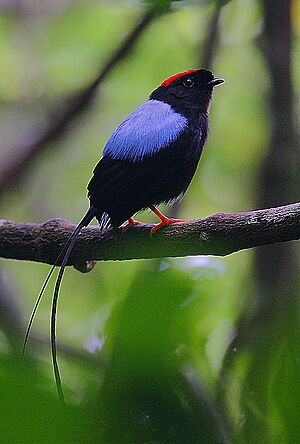 |
|
| Male long-tailed manakin (Chiroxiphia linearis) | |
| Scientific classification |
|
| Kingdom: | Animalia |
| Phylum: | Chordata |
| Class: | Aves |
| Order: | Passeriformes |
| Parvorder: | Tyrannida |
| Family: | Pipridae Rafinesque, 1815 |
| Species | |
|
Many, see text |
|
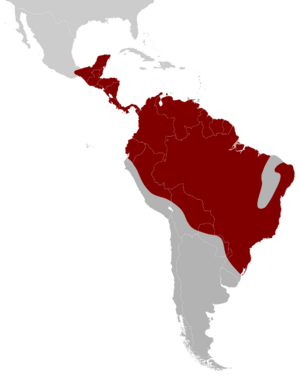 |
|
| Manakin range | |
Manakins are a family of small, colorful birds called Pipridae. There are 55 different kinds, or species, of manakins. You can find them across the tropical parts of America. The name "manakin" comes from an old Dutch word meaning "little man."
Contents
What are Manakins Like?
Manakins are small birds, usually between 7 and 15 centimeters (about 3 to 6 inches) long. They weigh about 8 to 30 grams (less than an ounce). They are compact birds with short tails and wide, rounded wings. They also have big heads and short beaks.
Most manakins show a cool difference between males and females. This is called sexual dichromatism. Females and young males are usually a dull green color. But adult males are often mostly black with bright patches of color. Some males even have long, fancy tail or head feathers!
Manakins have a special "voicebox" called a syrinx. It helps them make unique sounds like whistles, trills, and buzzes. Each type of manakin has its own special sounds.
Where Do Manakins Live?
Manakins live in many places, from southern Mexico all the way to northern Argentina, Paraguay, and southern Brazil. You can also find them on the islands of Trinidad and Tobago.
These birds love trees! They almost always live in forests and woodlands. Most manakins prefer warm, wet tropical forests. But some live in drier forests or along rivers. A few species even live in the mountains, like the Andes. Some of these mountain manakins move to different heights depending on the season.
Manakin Life and Habits
Feeding Habits
Manakins usually find their food in the lower parts of the forest. They mostly eat small fruit, like berries. Sometimes, these fruits are quite big for such small birds! They also eat some insects. Manakins often catch fruit while flying, similar to how some birds catch insects in the air. Scientists think this means they might have evolved from birds that mainly ate insects.
Female manakins have large areas where they look for food. They don't always keep other manakins away from their space. Males, however, spend a lot of time together at special places where they try to attract females. Sometimes, manakins will even join other types of birds to feed together.
Reproduction
Many manakin species have amazing courtship dances! These special shows are called "lekking" rituals. The males perform for the females. Each type of manakin has its own unique dance and sounds. They might jump, bow, vibrate their wings, snap their wings, or fly in acrobatic ways.
Some manakins, like the Club-winged manakin, have special wing feathers. They use these feathers to make buzzing and snapping sounds during their dances. Other manakins can move their wings super fast to create sounds!
After the courtship, the female manakin does all the work. She builds a cup-shaped nest, usually low in the plants. She then lays two eggs, which are usually dull white with brown marks. She sits on the eggs for about 18 to 21 days until they hatch. Then, she takes care of the young birds for another 13 to 15 days. Most manakins don't stay together as a pair after mating.
Species List
The manakin family, Pipridae, was first described by a French scientist named Constantine Samuel Rafinesque in 1815. Here are some of the different types of manakins:
| Image | Genus | Living Species |
|---|---|---|
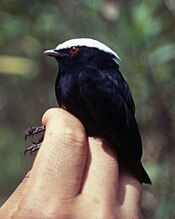 |
Pseudopipra Kirwan et al, 2016 |
|
 |
Pipra Linnaeus, 1764 |
|
 |
Ceratopipra Bonaparte, 1854 |
|
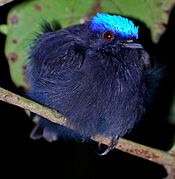 |
Lepidothrix Bonaparte, 1854 |
|
 |
Chiroxiphia Cabanis, 1847 |
|
 |
Ilicura L. Reichenbach, 1850 |
|
 |
Masius Bonaparte, 1850 |
|
 |
Corapipo Bonaparte, 1854 |
|
 |
Manacus Brisson, 1760 |
|
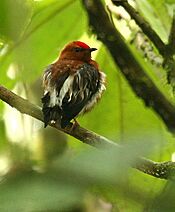 |
Machaeropterus Hahn, 1819 |
|
 |
Xenopipo Cabanis, 1847 |
|
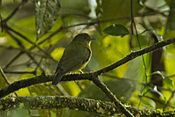 |
Cryptopipo Ohlson et al., 2013 |
|
 |
Chloropipo Cabanis & Heine, 1859 |
|
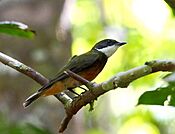 |
Heterocercus Strickland, 1850 |
|
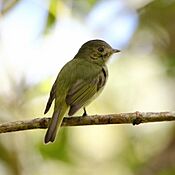 |
Neopelma P.L. Sclater, 1861 |
|
 |
Tyranneutes P.L. Sclater & Salvin, 1881 |
|

